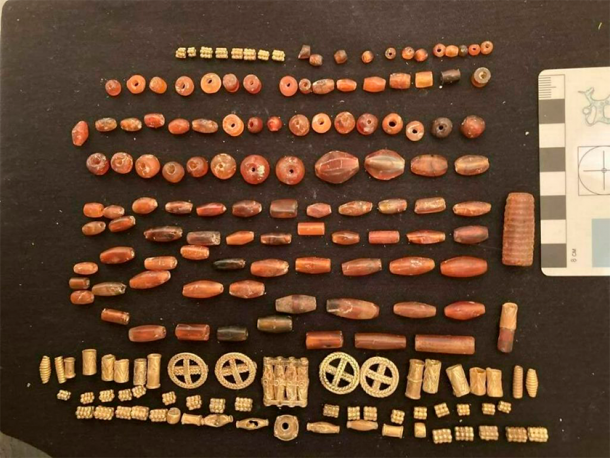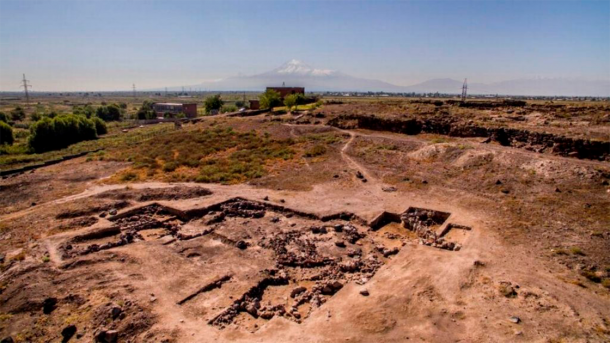Archaeologists recently opened a Late Bronze Age (c 1,200 BC) tomb at the huge Metsamor site in Armenia. Inside was a cornucopia of small gold artifacts, including dozens of loose pieces from three gold necklaces that must have been spectacularly beautiful when they were joined together. But even more remarkably, the tomb contained the bodies of a man and a woman who’d been buried side by side, locked in each other’s arms in a loving embrace that was obviously meant to last for eternity.
Were these two individuals star-crossed lovers, who like Shakespeare’s Romeo and Juliet met a tragic fate that prevented them from spending their lives together in this world? Did one die unexpectedly, provoking the other to commit suicide (as Romeo and Juliet did) so they could join their beloved in the afterworld?

Estimates are that the two people were in their 30s at the time of their deaths, so it does seem their deaths were somewhat premature. Unlike the fictional Romeo and Juliet, however, who ended up laying side by side in their tombs despite their family’s attempts to keep them apart, the two Bronze Age partners were intentionally buried side-by-side by family members or friends who chose to honor their relationship in death just as they’d respected it in life.
“Their death is a mystery to us, we do not know the cause, but everything indicates that they died at the same time, because there are no traces of the tomb reopening,” University of Warsaw archaeology professor and study participant Krzysztof Jakubiak said in a statement published by the organization by the Polish press agency PAP.
An Elaborately Furnished Tomb for the Ancient Romeo and Juliet
According to Artnet, the interior of the man and woman’s tomb was decorated with an assortment of attractive and interesting grave goods. This included a wooden burial bed, a faience flask (a type of tin-glazed ceramic pottery), and other types of ceramic vessels, the latter of which were intact. The flask was a luxury item that would not have been produced locally, but would have been imported from the borderland region of Syria and Mesopotamia.
In addition to the pieces of the gold, some of which were in the form of Celtic crosses , the Polish and Armenian archaeologists also unearthed more than a hundred amber and carnelian beads, which may also have attached to the three golden necklaces. All of the gold pieces and beads demonstrated high levels of craftsmanship, indicating an advanced jewelry making capacity among the residents of the lands of Armenia in the 13 th century BC.
The contents of the tomb clearly included items that had personal meaning to its occupants. In addition to the pieces of the broken necklaces that lay near them, the two bodies were adorned with bronze bracelets in the case of the woman and a tin wire ring in the case of the man.
The doomed Late Bronze Age couple were laid to rest inside a cist, a stone-lined chamber implanted in the ground and surrounded by heavy stones. At the time of their entombment their grave would have been covered with a burial mound, as would the 100 plus other graves that have been uncovered in the ancient necropolis at Metsamor over the years. But no traces of these mounds are left today. In fact, only a few of the more than 100 graves that have been discovered since excavations began in 1965 had not been looted by antiquities thieves, and archaeologists know that an extraordinary collection of valuable grave goods and other items have been stolen from Metsamor over the centuries.

Beads and gold pendants from a recently discovered tomb at the Metsamor necropolis in Armenia. Photo Credit: Science in Poland.
Tracing the History of Metsamor and its Mysterious Occupants
First excavated nearly six decades ago, Metsamor is one of the most well-known and prodigious archaeological sites in the republic of Armenia, a small country located just to the east of Turkey in the highlands of Western Asia. Metsamor can be found approximately 22 miles (36 kilometers) to the west of Armenia’s capital city of Yerevan.
The 2,200-year-old necropolis or cemetery at Metsamor is sprawling and massive, covering more than 250 acres (100 hectares). It was constructed next to a fortified settlement, which was larger than any village found in the area by archaeologists so far. A lot of graves have been discovered at the site since excavations were launched in the 1960s, but the hopes of archaeologists have been dashed time and again when it has been revealed that almost all of these graves was looted long ago and were therefore empty.

The newly discovered “golden tomb” at the Metsamor necropolis in Armenia. Photo Credit: Polish Center of Mediterranean Archaeology at the University of Warsaw.
The experts do not know who resided in the region around Metsamor in the Late Bronze Age. The residents who occupied the fortified village there did not have a written language, so they left behind no information about who they were or what they believed.
“But it was a great settlement,” Professor Jakubiak stated. “Even fortifications made of huge stone blocks have survived to our times, encircling the so-called the citadel. At the end of the 2nd millennium BC, there was no settlement in the region that could be compared in terms of rank and size.”
During its peak of prehistoric prosperity, which lasted from the fourth through the second millennium BC, the settlement was spread out over 25 acres (10 hectares) and was surrounded by stone walls. Even more glorious days were to come, and Metsamor grew during the early Iron Age (11th to 9 th centuries BC) to nearly 10 times this size, and featured a central area that included multiple temple complexes and sanctuaries. In the eighth century BC Metsamor was absorbed into the large regional kingdom of Urarat, which is referred to as Ararat in the Bible.
The excavations that unearthed the carefully posed bodies of the ill-fated couple took place in the autumn of last year. Joint Polish-Armenian explorations at Metsamor have been ongoing on a seasonal basis since 2013, and will continue at a location that has proven to be incredibly fertile and productive for archaeologists investigating the history of this region of Western Asia.
Top image: Two skeletons embracing. Note, this is representational and not the find in Armenia ( Dagmar Hollmann / Wikimedia Commons. CC by SA 4.0)
By Nathan Falde
Source: ancient-origins.net








